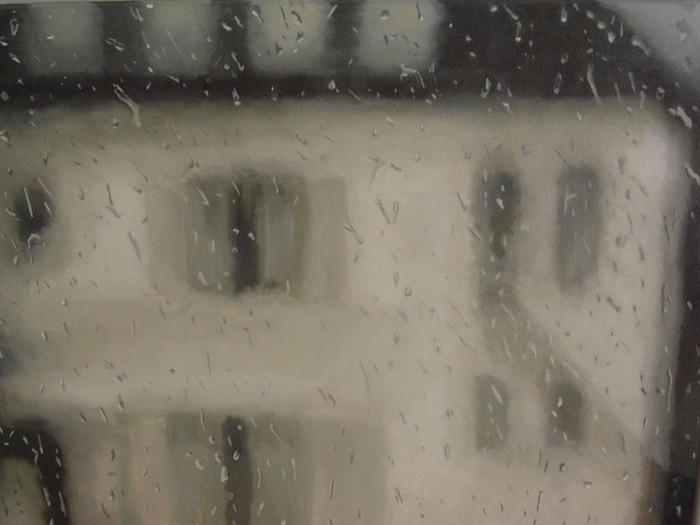Stephen Skidmore
29 Jan - 07 Feb 2009
Late in the Afternoon
For the past thirty years Stephen Skidmore has worked from his small room, first in gouache and acrylic, then in oils, accumulating the contents of at least four unseen exhibitions. In the early days, his landlady told him he couldn’t have pictures on the walls, so he kept them under his bed. Now it’s too late for that.
We met in the heady days of conceptualism at Nottingham School of Art, where there was no course to speak of, and certainly no instruction in painting. Steve instead built a working all-day breakfast café in the studio. All the internationalists around thought this was directly influenced by Matta Clark and Les Levine, but how could he have heard of them. Really it was just the full-English. At the end of each day, Steve went home to his room and learned how to paint by himself.
He has made shows with Rüdiger Schottle and Jörg Johnen, and Laure Genelliard amongst others, and he has participated in many a group show. When the sculptor Tony Cragg saw one of his plastic bottle paintings in the mid-eighties, Tony said he would get Steve to do all his documentation! Those sequences of bottles preoccupied him for a long time, maybe a full twenty five years, until this new group of commuters in transit, Late in the Afternoon.
Stephen Skidmore needs a break from his relentless accumulation of pictures.
From his bed-sitter in Avenue Crescent in Acton in West London, now ironically renamed ‘studio apartment’ for rental purposes, he has recently painted the distorted scene through the rain falling down his windows. They are strong new paintings, with more than a passing ressemblance to the broad brush-work of late Sickert, and even in their subject. Yet as usual they relate more to the sequence and seriality engendered through photography and film, the serial figuration of his friends Michael Van Offen and Wolfgang Koethe.
He is the model if not the cartoon of what we know exists as the garret-artist, but he has always been almost contemporary in the best sense of painting, the sense of Baudelaire’s The Painter of Modern Life. But it may be that in this distance he has the proper space and consideration to continue to look out of his window at the rain falling in Acton.
Simon Cutts. August 2008
For the past thirty years Stephen Skidmore has worked from his small room, first in gouache and acrylic, then in oils, accumulating the contents of at least four unseen exhibitions. In the early days, his landlady told him he couldn’t have pictures on the walls, so he kept them under his bed. Now it’s too late for that.
We met in the heady days of conceptualism at Nottingham School of Art, where there was no course to speak of, and certainly no instruction in painting. Steve instead built a working all-day breakfast café in the studio. All the internationalists around thought this was directly influenced by Matta Clark and Les Levine, but how could he have heard of them. Really it was just the full-English. At the end of each day, Steve went home to his room and learned how to paint by himself.
He has made shows with Rüdiger Schottle and Jörg Johnen, and Laure Genelliard amongst others, and he has participated in many a group show. When the sculptor Tony Cragg saw one of his plastic bottle paintings in the mid-eighties, Tony said he would get Steve to do all his documentation! Those sequences of bottles preoccupied him for a long time, maybe a full twenty five years, until this new group of commuters in transit, Late in the Afternoon.
Stephen Skidmore needs a break from his relentless accumulation of pictures.
From his bed-sitter in Avenue Crescent in Acton in West London, now ironically renamed ‘studio apartment’ for rental purposes, he has recently painted the distorted scene through the rain falling down his windows. They are strong new paintings, with more than a passing ressemblance to the broad brush-work of late Sickert, and even in their subject. Yet as usual they relate more to the sequence and seriality engendered through photography and film, the serial figuration of his friends Michael Van Offen and Wolfgang Koethe.
He is the model if not the cartoon of what we know exists as the garret-artist, but he has always been almost contemporary in the best sense of painting, the sense of Baudelaire’s The Painter of Modern Life. But it may be that in this distance he has the proper space and consideration to continue to look out of his window at the rain falling in Acton.
Simon Cutts. August 2008

